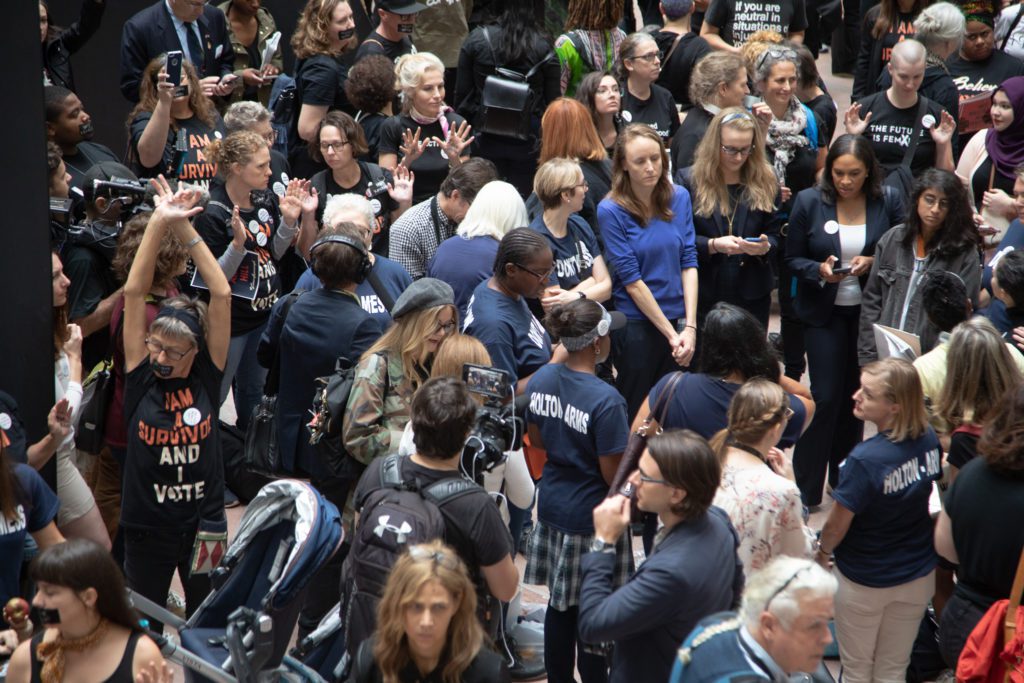Capitol Newspeg: Democracy Is Alive and Well on the Hill
By • October 1, 2018 0 498

It has been a tumultuous few weeks on Capitol Hill. The confirmation hearing for Supreme Court nominee Brett Kavanaugh has elicited widespread and visibly heated emotions and demonstrations from all the stakeholders, opponents and supporters, pundits, legal analysts and, in this case, especially psychologists.
The halls in front of the Senate Judiciary Committee hearing rooms in the Senate Hart and Dirksen Office Buildings and the broad steps at the entrance to the Supreme Court have been filled with vociferous advocates. They wave signs, chant slogans, wear costumes and speak on bullhorns — all covered by a crowd of eager news reporters and producers toting cameras, lights, batteries, notepads and pens.
We congressional reporters have found the past week’s events to be frankly exciting, interesting and, yes, even fun to cover. We love reporting a breaking news story, being the eyes and ears for our audiences in the very eye of the storm. We love having the credentials to go just about everywhere on the Hill and to ask anyone questions. We love the competition to get a scoop: new news.
For those of us who have been covering the Hill for years, even decades, we also are eager to share some perspective. We have been there long enough to know how things usually work and what is unusual. We have seen the political tides of each party’s leadership come and go. We have been trained to cover all sides and to be as impartial as possible.
Journalists with congressional credentials must be particularly careful to be impartial. Our credentials are granted us yearly by a committee of peers. We and our publications have to be vetted as real news organizations, not advocates for a particular issue or group. If we are ever found to be lobbying legislators for a bill or advocating in public for a particular policy, our credentials can be yanked immediately. In hearings, and especially in the press galleries overlooking the House and Senate, we are strictly forbidden to applaud or show any indication of favor towards any position, member of Congress, staff member or visitor.
Most of us who cover Congress greatly prefer the Hill beat to covering the White House, even though that may be considered more of a star-reporter assignment, with even the rare chance to ride on Air Force One. But in the White House, you really only cover one person: the president. Your sources are all administrative spokespeople, with whom it is increasingly difficult to establish trusting off-the-record relationships.
In Congress, there are 535 elected representatives and senators to cover, along with thousands of staffers. Every elected official has at least a chief of staff, a legislative aide (often several) and a press secretary, all of whom are important contacts for the congressional reporter. In addition, there are the dozens of standing committees and subcommittees that each elected official serves on. The committees and subcommittees are serviced in turn by majority and minority staffs.
Then there are the thousands of lobbyists, issue advocates, experts and legal counselors who roam the congressional halls and advise elected officials about legislative positions. Some even write much of the proposed legislation. To properly cover the beat, congressional reporters have to know and, often, develop relationships with them.
And a good reporter also includes as news contacts the ubiquitous Capitol employees he or she encounters daily. They include some of the hundreds of Capitol police, administrators and maintenance and service workers — from research librarians to eatery personnel (like the staff of the great little grill in the Senate basement), from barbers to office painters. Some of them have been there for years. They see things, they know things and, sometimes, they talk.
Oh yes, Congress is a very exciting and vibrant place to cover as a journalist. It is also frustrating, of course, to watch the almost impossible process to get a legislative proposal (a bill) through sponsoring elected officials, into and then out of the subcommittee and the full committee, onto the floor for debate and sometimes a vote, to the other chamber for the same process, back to a compromise committee of both houses and then to a vote on the final write-up in both chambers before the president can sign it into law. The process takes longer and longer. Most bills never make it through and are reintroduced year after year.
Many decry that Congress is broken. The complaints, suggestions, accusations, defenses, compromises and dealmaking — all of that is becoming increasingly heated. Political rhetoric has become “weaponized,” as they say, and whole populations of new voters are getting engaged.
Yes, the work of Congress is messy, loud, annoying and frustrating. But one thing is clear to this congressional reporter at least (who also covered the United Nations in Geneva for several years). This is truly American democracy in action. Democracy in the good ol’ U.S.A. is vibrant, loud, visible and totally alive and well.
This is the first of a series of Capitol Newspeg pieces by Georgetowner reporter Peggy Sands on news from the Hill.

